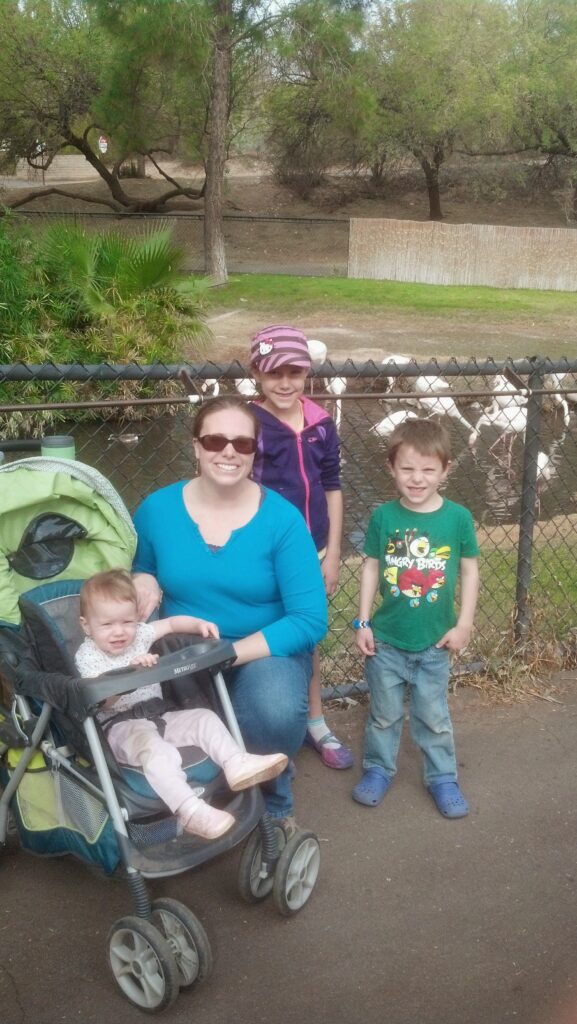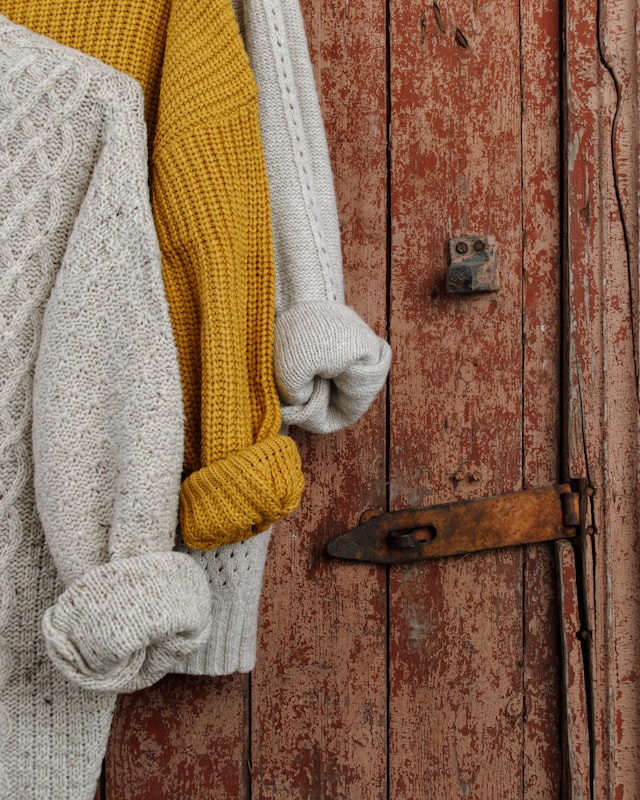My Story –

It was 2012 and I had 3 kids: ages 8, 4, and 1. We went to the Zoo with a large group of 20 homeschool families for an all-day field trip. My kids loved it. They had a great day with friends, seeing giraffes and elephants, running along the paths, and eating kettle corn. The other families had fun chatting with each other, taking pictures, and letting the kids play as we walked with the little ones in strollers.
I was miserable and doing my best to hide it. By the time we got back to the van, as the Phoenix Zoo was closing for the day, I was shutting down hard. I got all the kids buckled in their car seats and then I sat there and sobbed. I was so drained. I had no idea if I would be able to do the 45-minute drive home. I still had 3 major freeways to navigate in rush hour traffic. My husband was out of town on a business trip and I could not think of anyone who could help me. I felt exhausted, alone, and I was scaring my kids.
I had no idea why I was a failure as a mother and I was so miserable when everyone else had a great day.
I did not understand then that several different factors were happening that day that made it difficult for me to be comfortable, or even successful in that situation. Looking back now I can see what it was about that day that made it very draining for me.
Things that made me uncomfortable and caused me to use up my emotional reserves that day at the Zoo:
- It was socially awkward – I was new to the group and still trying to navigate the social dynamics.
- The wind – It was pushing us and making my long ponytail wack me in the face most of the morning.
- I ran out of food – I did not realize that the Zoo would turn my kids into ravenous creatures who would eat all of our snacks and lunch supplies by 11am. I didn’t have the budget to buy stuff from the food stands and so I did what I could to buy cheap snacks along the way… But I was hungry and I ran out of coffee. 😣
- I forgot a sweater – I grabbed light jackets for all the kids, but I forgot one for me. I was cold most of the morning. Especially with the wind…
- Multiple conversations – The group walked through the zoo together and the moms were in constant conversation with each other. I tagged along with several people but I struggled to hear what they were saying. When I did jump in I often said the “wrong” thing.
- The shirt I was wearing was too tight – It was laundry day and I was wearing a shirt that did not fit me correctly. Before we even left the house I was uncomfortable but it looked nice so I didn’t change.
- LOUD NOISES – kids shouting, other moms barking instructions, the Zoo train driving by, animals, more people, birds squawking, the wind (did I mention that yet…?)
- Bad shoes – the sneakers that I picked to wear that day were worn out. They were coming apart and hurting my feet.
- In the afternoon there was a light rain – it was pleasant at the time but then I got wet and everything in the stroller got wet. Then I got cold and there was chaffing on my arms and legs.
- The variety of needs for all my kids – Each kid wanted to do different things and needed different things from me all day long. It was a constant juggling act of small humans.
Seeing all of those things now I can see why I had a meltdown when I got into the van. Really it is amazing to me that I was able to keep going after 1pm.
So let’s break this list down to see what was going on under the surface that I did not understand.
I am not an expert in these areas. In fact, I’ve barely dipped my toe in the water. But I wanted to put all of the information that I have learned in one place. I like to have a place of reference. A post to send someone to if I’m in a conversation about the way I interact with this overwhelming world.
Consider this a gentle place to start on these heavy and complicated topics.
Finding Resources
There is a massive amount of resources out there some of them with negative or bad information. The first thing that I consider when looking at a source is how they approach the term neurodiversity.
Neurodiversity describes the idea that people experience and interact with the world around them in many different ways; there is no one “right” way of thinking, learning, and behaving, and differences are not viewed as deficits. The word neurodiversity refers to the diversity of all people, but it is often used in the context of autism spectrum disorder (ASD), as well as other neurological or developmental conditions such as ADHD or learning disabilities.
– What is neurodiversity? By Nicole Baumer, MD, MEd
Quick Questions I ask to help find helpful resources:
- How does this resource approach the human experience?
- Are they trying to “fix” certain types of people or mold others to behave differently?
- How do they approach the positive side of the term?
- Do they discuss the benefits or only the negative side?
- What is the purpose of the video, book, class, or information? Why was it written?
Autism & Asperger’s
For this conversation, we will consider Asperger’s and Autism to be the same thing. But technical labels are often changing and can be a very personal thing.
Understanding the experience has taken some time. I have known and understood autism (as an educator) for all of my adult life. However, when I heard about what the experience is like from the inside, that changed everything for me.
A few years ago my cousin began exploring the world of autism and, in an effort to be supportive, I decided to learn more as well. What I found was shocking to my system. I discovered descriptions of my inner life and understanding in a community that I had not experienced before. “These people get me!” was my constant thought. It was satisfying and unsettling at the same time.
Autism runs in families. The most recent research is stating that it is mostly genetic. That explains some family quirkiness that has been going on for generations. It also explains some unspoken family dynamics that may be hard to explain to outsiders. “This is just the way we do things.” or “This is just the way it is done.” These were the reasons I would often hear from grandparents or other older relatives.
Autistic characteristics can look very different from person to person. This depends on personality, upbringing, lifestyle, and masking levels. There is a huge variety of how these neurodiverse traits show up. There is also a spectrum of autism that plays out differently depending on your specific situation.
Resources I found helpful:
- What AUTISTIC people wish you knew – Yo Samdy Sam
- Are You Autistic? 25 Questions To Ask Yourself! – Autism From The Inside
- Morgan Harper Nichols (AZ artist + poet on Instagram)
HSP – Highly Sensitive People
Another piece of who God has created me to be is being an HSP. I am very sensitive to outside input. Extended loud noises, strong wind, multiple conversations happening at once, violent TV shows, and cold weather can shut me down quickly. It is especially difficult for me to process several inputs at once.
I am a terrible multi-tasker. Especially out in public. This can be tricky when you are a mom. Mothering is a job full of interruptions, multi-tasking, and small meaningless tasks strewn together. Like when you have 4 young kids on a field trip with a large group at the Zoo…for example. 😐😣
I encountered this HSP concept a few years ago and found it helpful in explaining some things I struggle with.
In the past, before I realized why these things bothered me, I would just keep gritting my teeth and pushing through. I would use up so much self-control that I would be angry at my kids and harsh towards Jim. Then I would crash afterward. It took a few days of recovery time to feel like myself again. I was becoming resentful toward the world that felt like too much. It was a lot. I wish I would have learned about this sooner so I could have avoided years of pain.
Resources that have helped me understand Highly Sensitive People:
- Book = Introverted Mom by Jamie C. Martin
- This awesome book was a gentle beginning to my journey in accepting myself at a deeper level. She shares her perspective of being an introvert with extroverted kids and being HSP with young kids.
- She also has a beautiful online community full of encouragement and resources.
- Book = The Highly Sensitive Parent & The Highly Sensitive Person in Love by Dr. Elaine Aron
- I enjoyed these as audiobooks while I cleaned out our old RV before we sold it and during a long drive. I recommend listening to these helpful books. Because the author was reading the information to me I did not stop and overthink it. I just listened and absorbed the information. It was good for me to get a full overview.
- Here is a great online resource for deciding if you are HSP or have HSP tendencies. (free test)
Texture Sensitivity

This is something I have delt with most of my life and it has often decided my personal style. I do not like feeling physically uncomfortable, specifically with clothing. I have always refused to wear high heels, make up, clothing that is tight or constrictive, and even t-shirts with high necklines. (Let’s just say that I would have been miserable if I was in London in the 1800’s with corsets and complicated dresses.) Most of what I wear is based on simplicity and comfort.
Below is my gathered list to being more comfortable in difficult or draining social situations. I have worked on this list for a few years and it has made a huge difference. I use a few of these at big family parties, on homeschool field trips, holiday gatherings, large events at church, and in awkward social situations. My needs are different for each event so I pick and choose what matters to me that day. I encourage you to make a list that works for you.
The List “Tips for Enjoying Complicated Social Situations”:
- Plan to get rest the night before so you don’t show up depleted. Reserve energy for the event.
- If you know of someone who isn’t as socially draining for you, reach out and plan to hang out with them or have them save you a seat.
- Wear comfortable clothes and shoes! This is my #1 tip. Seriously it makes a big difference.
- Choose jewelry that does not make noise or clang against you (no dangly jingle bell earrings!)
- Bring a water bottle and a drink you enjoy (coffee, tea, soda, orange juice)
- Pack snacks so you don’t have physical needs overwhelming you. You have what you need.
- Pack fidgets or other sensory relieving tools. Bring your knitting or a color page.
- Plan your arrival time based on your needs.
- If being late is overwhelming come early.
- Or if getting there too early extends the overwhelm, go appropriately late.
- Take bathroom breaks for quiet and space. Sometimes just a few minutes of deep breathing will give you enough quiet to keep going in noise and chaos.
- Have specific questions to ask others or topics to discuss. Plan for social awkwardness and think of ways to make it better.
- When at the event and feeling overwhelmed take a break from the conversation. Look around and make observations about where you are. Enjoy nature, the location, and find beauty.
- Ask good questions and then listen well. People really just want to be seen, heard, and acknowledged. What you say is not as important as giving someone space to talk.
- Pay attention to your schedule before and after the event. Plan social rest.
- Calming Music on the car ride home.
- Quiet time at home.
- A walk alone.
- Reading a book or watching a movie.
- Mindless household chores with quiet.
- Journaling – What went well? Who was draining and difficult? What was enjoyable? What would you have done differently?
- If this is a social situation that happens regularly in your schedule I recommend creating a routine for it. Check out this printable and article for more: Life-Giving Routines – Printable Guide
[My friend Erin helped me with this list. She is amazing at using tools and planning.😁]
The key to all of this self-knowledge for me has been awareness. There are some events and things that I choose to avoid and then others that I know will be hard but worth it. I feel more in control of myself and my experience when I have a few tips to get me through. Knowing ahead of time some things I can do to be more successful helps me enjoy the moment. I find I have less recovery time and more energy. I get to be myself and be more comfortable.
I wish that for you as well. I hope that exploring these ideas will give you some self-knowledge and insight. When we know how God has created us, we can show up in the world more fully alive. That is what we want for ourselves and for our loved ones.
Questions for reflection:
See if any of those list items ring true for you. Ask yourself some hard questions. Do some journaling.
– What situations are difficult for you to feel comfortable in? Why?
– Where do you go where you feel like yourself? Who are you with? What do you do?
– What clothing do you wear that you enjoy? What feels constrictive and annoying?
– How does the weather affect you? Do you have a hard time in certain temperatures or conditions?
I hope that you take the time to look over the resources I listed above and take a rabbit trail of learning that interests you.
Wishing you moments of quiet, with soft blankets, & calm.
💟 – April
Photo by Jacek Dylag / Toa Heftiba on Unsplash

